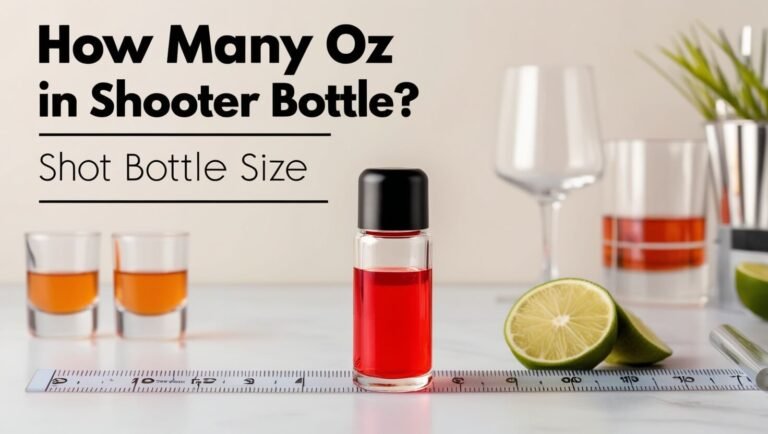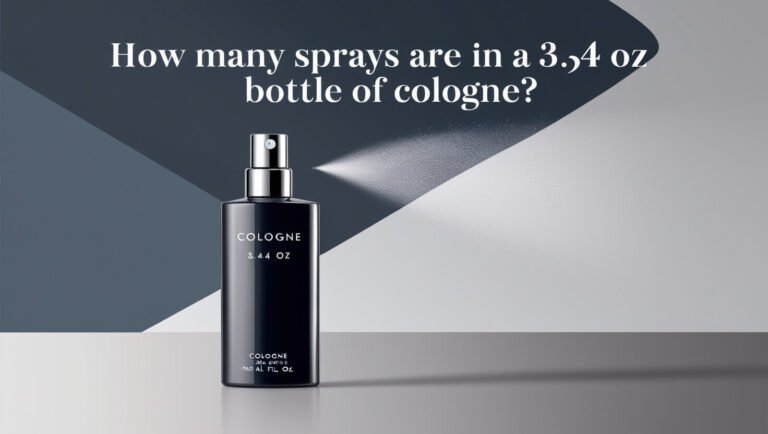How Many Oz in a Bottle: Standard Liquid Measurements Chart

Ever wondered how to measure a bottle’s contents accurately? It’s crucial for mixing drinks, pouring wine, or tracking water intake. This guide will cover everything from liquor sizes to water bottle dimensions. You’ll learn to convert liquid measurements like a pro!
Common Bottle Sizes and Their Measurements
Knowing the different sizes of beverage containers is key. Each size has its own use and benefits. Let’s explore the common sizes and what they measure.
Standard Liquor Bottle Volumes
Liquor bottles come in various sizes. You’ll find Nip or Miniature (50 ml or 1.7 oz), Half Pint (200 ml or 6.8 oz), and Demi (350 ml or 11.8 oz). There’s also Fifth (750 ml or 25.4 oz), Liter (1,000 ml or 33.8 oz), and Half Gallon (1,750 ml or 59.2 oz).
Less common sizes include Magnum (1,500 ml or 50.7 oz), Jeroboam (3,000 ml or 101.4 oz), and Rehoboam (4,500 ml or 152.1 oz).
Wine Bottle Measurements
In the U.S., the standard wine bottle is 750 ml. This is about 25.36 ounces or 17 1.5-ounce shots. It’s used worldwide for red and white wines.
Beer Container Sizes
Beer bottles and cans vary in size. You’ll find everything from 12 oz. (355 ml) to larger kegs. Here are some common sizes:
- 12 oz. (355 ml) can or bottle
- 16 oz. (473 ml) can or bottle
- 24 oz. (710 ml) can or bottle
- 12 L (3.17 gal) keg
- 20 L (5.28 gal) keg
- 30 L (7.93 gal) keg
- 50 L (13.21 gal) keg
- 58.6 L (15.47 gal) keg
Knowing these drink container sizes, beverage packaging, and ounce calculation tips helps when buying or drinking your favorite drinks.
How Many Oz in a Bottle: Essential Conversion Charts
Understanding liquid measurements can be tricky. But with the right charts, you’ll get it in no time. Whether it’s small essential oil bottles or big containers, knowing liquid capacity and fluid ounce conversions is key.
Let’s explore the essential conversion charts. They’ll help you understand different liquid measurements:
| Volume | Milliliters (ml) | Fluid Ounces (oz) | Drams (dr) |
|---|---|---|---|
| 5 ml | 5 | 0.17 | 1.76 |
| 10 ml | 10 | 0.33 | 3.53 |
| 15 ml | 15 | 0.5 | 5.29 |
| 30 ml | 30 | 1 | 10.58 |
| 50 ml | 50 | 1.69 | 17.64 |
| 100 ml | 100 | 3.38 | 35.27 |
| 250 ml | 250 | 8.45 | 88.18 |
| 500 ml | 500 | 16.91 | 176.36 |
| 1000 ml | 1000 | 33.81 | 352.72 |
| 1 liter | 1000 | 33.81 | 352.72 |
| 1 gallon | 3785.41 | 128 | 1344 |
These conversions are crucial for liquid capacity, bottle servings, and fluid ounce measurements. Use this chart whenever you need to switch between different liquid volume units.
Popular Drink Serving Sizes and Portions
Knowing the standard serving sizes of alcoholic drinks is key, whether you’re hosting a party or out at a bar. In the U.S., a shot is 1.5 ounces, and a standard wine pour is 5-6 ounces.
Shot Measurements and Standards
There’s no federal rule for liquor drink sizes, but 1.5 ounces is the usual shot size in the U.S. Some places might offer shots that are 1 ounce or 2 ounces, based on their style and who they serve.
Cocktail Pour Guidelines
Cocktail sizes can differ, but a common rule is 1-2 ounces of base spirit per drink. This makes for a balanced and tasty cocktail, with the right amount of alcohol. About 80% of bars in 20 states pour cocktails at 1.5 oz, while some big chains might pour at 1.25 oz.
Wine Serving Portions
For table wines, champagnes, and sparkling wines, the standard serving size is 5 ounces per glass. A 750 ml bottle of wine can serve around 10 people. A 1.5-liter bottle, or Magnum, can serve about 20 people.
| Drink Type | Typical Serving Size | Servings per Bottle |
|---|---|---|
| Wine (750 ml bottle) | 5 ounces | 10 servings |
| Wine (1.5 liter bottle) | 5 ounces | 20 servings |
| Liquor (1 liter bottle) | 1.5 ounces | 90 servings |
By knowing these drink servings, alcohol portions, and cocktail measurements, you can plan better and enjoy your drinks more, whether at home or out.
Global Bottle Size Standards and Comparisons
The international liquor industry mostly uses standard bottle sizes. But, there are some differences in different regions. In the United States, wines and spirits usually come in 750 ml bottles. In Europe, it’s often 700 ml. Japan prefers 720 ml bottles for sake, and Australia uses 700 ml for spirits.
Larger bottles are also available, with sizes varying by region. You can find magnums (1.5 L), jeroboams (3 L), and even the huge nebuchadnezzar (15 L). The nebuchadnezzar holds as much as 20 standard 750 ml bottles or about 100 glasses of wine.
| Bottle Size | Typical Contents | Regional Variations |
|---|---|---|
| 750 ml | Standard for wines and spirits in the USA | 700 ml is common in Europe, 720 ml for sake in Japan |
| 1.5 L | Magnum, double the standard bottle | Equivalent to 10 glasses of wine |
| 3 L | Jeroboam, four times the standard bottle | Often used for special occasions and celebrations |
| 15 L | Nebuchadnezzar, equivalent to 20 standard bottles | Approximately 100 glasses of wine |
These standards and comparisons show the variety in the global liquor industry. They let consumers pick the size and format that fits their needs and tastes.
The Bottom Lines:
This guide has given you a detailed look at different bottle sizes and their volumes. You now know how to handle liquid measurements. We’ve covered everything from water bottles to wine servings. This knowledge is useful for anyone, whether you’re a bartender, a home mixologist, or just someone who likes to stay hydrated.
A standard 16.9-ounce water bottle is about 500 milliliters. Larger 1-liter bottles hold 33.8 ounces. The 8-12 ounce range is great for quick drinks or for kids.
Knowing these liquid measurement guide and bottle size summary facts helps you measure drinks right. It also helps you manage your inventory and stay hydrated.
By learning to convert between ounces, milliliters, and other units, you’ll be more confident. You’ll be able to handle different beverage containers with ease. This makes you more informed and efficient in your work or daily life.
Popular Questions:
What are the most common bottle sizes for liquor, wine, and beer?
Liquor bottles usually come in 750 ml (fifth), 1 liter, and 1.75 liter (handle) sizes. Wine bottles are mostly 750 ml. Beer sizes range from 12 oz cans to large kegs.
How do I convert between fluid ounces and milliliters for different bottle sizes?
Our charts help you convert between drams, milliliters, and ounces. For example, 1 ounce is 30 ml or 8 drams. Sizes range from 5 ml to 64 oz.
What are the standard serving sizes for alcoholic drinks?
In the U.S., a shot is 1.5 ounces (44 ml). A standard wine pour is 5-6 ounces (150-180 ml). Cocktail pours can be 1-2 ounces of spirit, depending on the place.
How do bottle sizes differ between countries?
In the U.S., 750 ml is standard for wine and spirits. Europe often uses 700 ml bottles. Japan’s standard is 720 ml, especially for sake.
Australia commonly uses 700 ml for spirits. Larger formats like magnums and jeroboams also vary by region.




